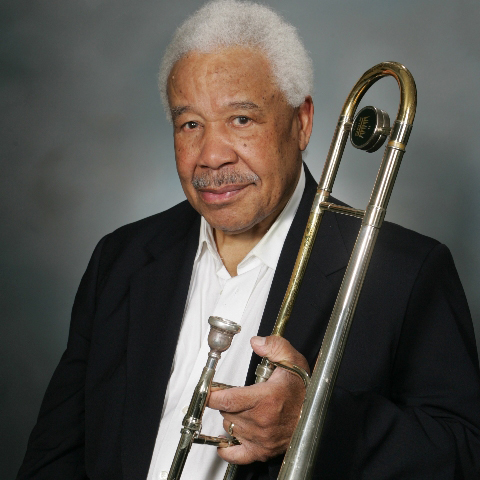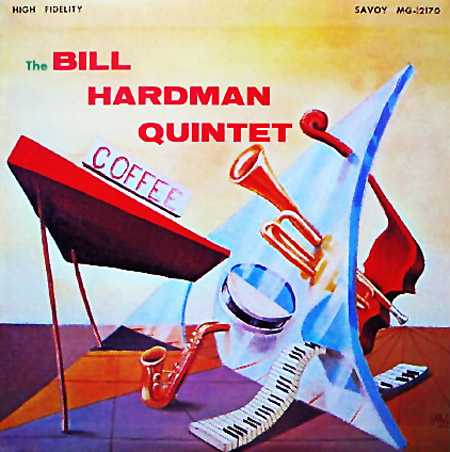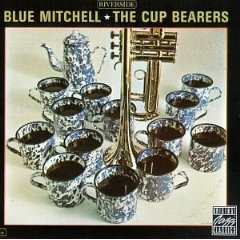Capers – Tom McIntosh
A memorable melody built on triads that brings to mind a swinging bugle call. Two different arrangements both with second parts.
- Recording: Bill Hardman - Bill Hardman Quintet
- Recorded on: October 18, 1961
- Label: Savoy (MG 12170)
- Concert Key: B-flat minor
- Vocal Range: , to
- Style: Swing (medium up)
- Trumpet - Bill Hardman
- Alto Sax - Sonny Red
- Piano - Ronnie Mathews
- Bass - Bob Cunningham
- Drums - Jimmy Cobb
Video
- Description
- Historical Notes
- Solos
- Piano Corner
- Bass Corner
- Drum Corner
- Guitar Corner
- Inside & Beyond
- Minus You
The bridge settles into 4-feel, but (unlike Blue's) ends with a hit on the "and" of beat 4 in the 7th measure; the 8th measure is a break. The C section is arranged identically to the second A section. In keeping with the rhythm section's "breaks", Hardman articulates the melody a lot more staccato than Mitchell; quarter notes (such as in measures 4 and 7 of the A section) are generally short. The horn harmony on Hardman's second A and C sections are slightly different than Mitchell's, but the bridge is harmonized the same. The rhythm of the bridge melody, however, is interestingly different: several of the notes where Mitchell anticipates the downbeat (using the "and" of beat 4) are in Hardman's version played right on the downbeat—but the only downbeat (measure 3) that Mitchell plays is one of the ones Hardman anticipates! In the solos, there are pedal point rhythm section figures for the first 5 measures of the bridge on both versions; in Hardman's it is simply beats 2 and 4. The codas are similar but with very slightly different melodies and horn harmonies.
There are three other, very different recordings of this song from the early '60s. Hubert Laws
Willie Bobo, on "Bobo's Beat", plays this song at about the same tempo as Laws, but with a Latin feel throughout latin; the intro is completely different. The hits on the A section are the same as Mitchell's; the coda is more like Hardman's but in time.
Finally, James Moody's version from "Running The Gamut" is the fastest fastest, again with subtly different rhythms. The entire melody in this two-horn arrangement is played in octaves; the intro is essentially the same as Hardman's and Mitchell's, and the coda is like Mitchell's but again without horn harmonies.
Later in 1962, Capers received a Latin treatment by Willie Bobo on his "Bobo's Beat" album for Roulette Records. Also, both Hubert Laws and James Moody recorded Capers in 1964.
These voicings by pianist Michael Cochrane use mostly fourth- and fifth-based structures. They are all spread out over more than one octave, and at times more than two. Many of these voicings contain at least one upper extension of the chord such as the 9th or 13th. The B-flat minor chord at the beginning of the A sections is interpreted as a B-flat minor 6th chord with a 9th. The three A sections are voiced differently. There is one chord substitution: the second measure of the second A section has a G-flat diminished 7th instead of the C minor 7th with a flat 5th. Both chords contain C, E-flat and G-flat.
These footballsfootballs show one way Michael hears the solo chord progression move from chord to chord. When studying them, your concentration can be focused solely on the chord progression and how chords move from one to another. Rhythmically, it's simple whole notes and half notes, or the basic harmonic rhythm of the chord progression of the solo section. The footballs are also annotated, showing the original chord symbol above the voicing, as well as any extensions below the voicing. The idea is that these voicings could be of varied uses to any level of pianist—a beginner pianist could play the music exactly as on the page and provide a supportive and harmonically hip sounding accompaniment to a soloist, while a more advanced pianist could use these same voicings with varied rhythms in the style of the recording. Ultimately, a pianist would be able to absorb how these voicings were derived from the chord symbols, and then be able to create their own.
Related Songs
Email Send Capers to a friend
- Recording: Blue Mitchell - The Cup Bearers
- Recorded on: August 28 & 30, 1962
- Label: Riverside (RLP 439)
- Concert Key: B-flat minor
- Vocal Range: , to
- Style: Swing (medium up)
- Trumpet - Blue Mitchell
- Tenor Sax - Junior Cook
- Piano - Cedar Walton
- Bass - Gene Taylor
- Drums - Roy Brooks
Video
- Description
- Historical Notes
- Solos
- Piano Corner
- Bass Corner
- Drum Corner
- Guitar Corner
- Inside & Beyond
- Minus You
The bridge is 4-feel throughout, lacking Hardman's break at the end but harmonized almost the same. The C section melody is also harmonized, but differently from Hardman's with some passages in unison and octaves. The melody is articulated more smoothly throughout, with more syncopations in the bridge. The rhythm section pedal point figures in the bridge on the solos are 5 measures long, like in Hardman's version, but here they are a classic 2-measure riff resembling the rhythm section figures of Horace Silver's Baghdad Blues or Clifford Jordan's Highest Mountain. The coda is essentially the same as Hardman's, but Blue unexpectedly plays one note of the melody up an octave.
There are three other, very different recordings of this song from the early '60s. Hubert Laws
Willie Bobo, on "Bobo's Beat", plays this song at about the same tempo as Laws, but with a Latin feel throughout latin; the intro is completely different. The hits on the A section are the same as Mitchell's; the coda is more like Hardman's but in time.
Finally, James Moody's version from "Running The Gamut" is the fastest fastest, again with subtly different rhythms. The entire melody in this two-horn arrangement is played in octaves; the intro is essentially the same as Hardman's and Mitchell's, and the coda is like Mitchell's but again without horn harmonies.
Later in 1962, Capers received a Latin treatment by Willie Bobo on his "Bobo's Beat" album for Roulette Records. Also, both Hubert Laws and James Moody recorded Capers in 1964.
These voicings by pianist Michael Cochrane use mostly fourth- and fifth-based structures. They are all spread out over more than one octave, and at times more than two. Many of these voicings contain at least one upper extension of the chord such as the 9th or 13th. The B-flat minor chord at the beginning of the A sections is interpreted as a B-flat minor 6th chord with a 9th. The three A sections are voiced differently. There is one chord substitution: the second measure of the second A section has a G-flat diminished 7th instead of the C minor 7th with a flat 5th. Both chords contain C, E-flat and G-flat.
These footballsfootballs show one way Michael hears the solo chord progression move from chord to chord. When studying them, your concentration can be focused solely on the chord progression and how chords move from one to another. Rhythmically, it's simple whole notes and half notes, or the basic harmonic rhythm of the chord progression of the solo section. The footballs are also annotated, showing the original chord symbol above the voicing, as well as any extensions below the voicing. The idea is that these voicings could be of varied uses to any level of pianist—a beginner pianist could play the music exactly as on the page and provide a supportive and harmonically hip sounding accompaniment to a soloist, while a more advanced pianist could use these same voicings with varied rhythms in the style of the recording. Ultimately, a pianist would be able to absorb how these voicings were derived from the chord symbols, and then be able to create their own.
Related Songs
Email Send Capers to a friend

Tom McIntosh
February 6, 1927 – July 26, 2017
Born and raised in Baltimore, Maryland, trombonist and arranger/composer Tom McIntosh studied voice at the Peabody Conservatory in 1944. In 1950 he was stationed in Germany with an Army band, where he first encountered reedman James Moody, who was touring Europe with Coleman Hawkins. Nine years later, after graduating from the Juillard School in NYC, Mac was hired by Moody to play in his sextet. The sextet became a septet for the first Moody recording, simply titled "James Moody," recorded in Chicago in August, 1959, for the Argo label. This album also contained Tom's first recorded composition With Malice Toward None, which Tom arranged as well. Read more...


